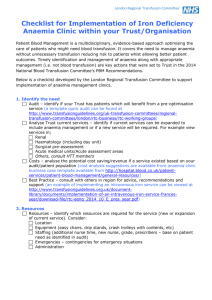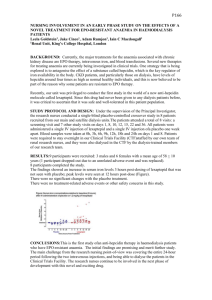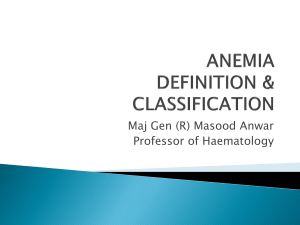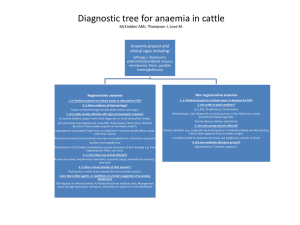Companion 3 PBM Guidelines
advertisement
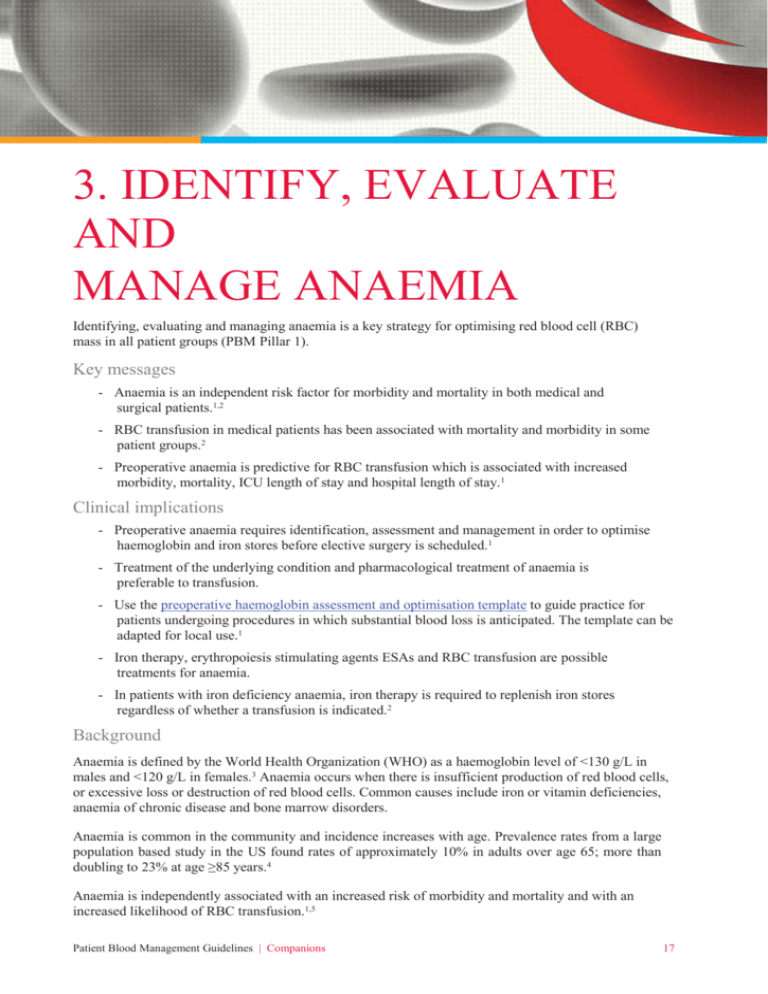
3. IDENTIFY, EVALUATE AND MANAGE ANAEMIA Identifying, evaluating and managing anaemia is a key strategy for optimising red blood cell (RBC) mass in all patient groups (PBM Pillar 1). Key messages - Anaemia is an independent risk factor for morbidity and mortality in both medical and surgical patients.1,2 - RBC transfusion in medical patients has been associated with mortality and morbidity in some patient groups.2 - Preoperative anaemia is predictive for RBC transfusion which is associated with increased morbidity, mortality, ICU length of stay and hospital length of stay.1 Clinical implications - Preoperative anaemia requires identification, assessment and management in order to optimise haemoglobin and iron stores before elective surgery is scheduled.1 - Treatment of the underlying condition and pharmacological treatment of anaemia is preferable to transfusion. - Use the preoperative haemoglobin assessment and optimisation template to guide practice for patients undergoing procedures in which substantial blood loss is anticipated. The template can be adapted for local use.1 - Iron therapy, erythropoiesis stimulating agents ESAs and RBC transfusion are possible treatments for anaemia. - In patients with iron deficiency anaemia, iron therapy is required to replenish iron stores regardless of whether a transfusion is indicated.2 Background Anaemia is defined by the World Health Organization (WHO) as a haemoglobin level of <130 g/L in males and <120 g/L in females.3 Anaemia occurs when there is insufficient production of red blood cells, or excessive loss or destruction of red blood cells. Common causes include iron or vitamin deficiencies, anaemia of chronic disease and bone marrow disorders. Anaemia is common in the community and incidence increases with age. Prevalence rates from a large population based study in the US found rates of approximately 10% in adults over age 65; more than doubling to 23% at age ≥85 years.4 Anaemia is independently associated with an increased risk of morbidity and mortality and with an increased likelihood of RBC transfusion.1,5 Patient Blood Management Guidelines | Companions 17 Anaemia is an independent risk factor for mortality and adverse cardiovascular outcomes in medical patients.2 In medical patients including those with cancer, the aetiology of anaemia is often multifactorial; where appropriate, reversible causes should be identified and treated.2 (MED-PP8) Preoperative anaemia is common in elective surgical patients. The prevalence ranges widely from 5% to 76%6 depending on age, co-morbidities and the nature of the underlying condition requiring surgery. Examples of reported prevalence rates include: - 24 ± 9% in hip or knee arthroplasty7 - 44 ± 9% in hip fracture repair7 - 26% ± 4% in cardiac surgery8 - 31 to 75% in colorectal surgery9 Preoperative anaemia is associated with an increased risk of adverse outcomes including increased morbidity, such as cardiac events, pneumonia and postoperative delirium; and up to an almost 5-fold increase in mortality.1-2,10-16 Preoperative anaemia has also been shown to be predictive for perioperative transfusion of allogeneic blood products such as red blood cells, which itself carries a significant risk of morbidity, mortality, ICU length of stay and hospital length of stay (PO-R2,R3).4,14-16 Preoperative anaemia requires identification, assessment and management in order to optimise haemoglobin and iron stores prior to elective surgery (PO-R1, PP1, PP4, PP5).1 The PBM guidelines: Module 2 - Perioperative contain a preoperative haemoglobin assessment and optimisation template to guide practice for patients undergoing procedures in which substantial blood loss is anticipated, such as cardiac surgery, major orthopaedic, vascular and general surgery. Specific details, including reference ranges and therapies, may need adaptation for local needs, expertise or patient groups.1 A case study has been developed to guide clinicians to implement preoperative anaemia assessment within their health care organisations. http://www.blood.gov.au/preoperative-anaemia- identificationassessment-and-management-case-study References 1. National Blood Authority. Patient Blood Management Guidelines: Module 2 – Perioperative. Australia, 2012. ` 2. National Blood Authority. Patient Blood Management Guidelines: Module 3 – Medical. Australia, 2012. 3. World Health Organization. United Nations Children’s Fund. United Nations University. Iron deficiency anaemia: assessment, prevention, and control. A guide for programme managers. Geneva: WHO, 2001. [Accessed 10 September 2012]. 4. Guralnik JM, Eisenstaedt RS, Ferrucci L, Klein HG, Woodman RC. Prevalence of anemia in persons 65 years and older in the United States: evidence for a high rate of unexplained anemia. Blood 2004;104:2263-8. 5. Kozek-Langenecker SA, Afshari A, Albaladejo P, Santullano CA, De Robertis E, et al. Management of severe perioperative bleeding: guidelines from the European Society of Anaesthesiology. Eur J Anaesthesiol. 2013;30:270382. 6. Shander A, Knight K, Thurer R, Adamson J, Spence R. Prevalence and outcomes of anemia in surgery: a systematic review of the literature. AmJ Med 2004; 116 (Suppl 7A):58S–69S. 7. Spahn DR. Anemia and patient blood management in hip and knee surgery: a systematic review of the literature. Anesthesiology. 2010;113(2):482-95. 8. Karkouti K, Wijeysundera DN, Beattie WS. Risk associated with preoperative anemia in cardiac surgery: a multicenter cohort study. Circulation. 2008 Jan 29;117(4):478-84. PubMed PMID: 18172032. Epub 2008/01/04. eng. 9. Edna TH, Karlsen V, Jullumstro E, Lydersen S. Prevalence of anaemia at diagnosis of colorectal cancer: assessment of associated risk factors. Hepato-gastroenterology. 2012 May;59(115):713-6. PubMed PMID: 22469713. Epub 2012/04/04. eng. 18 Patient Blood Management Guidelines | Companions 10. Gombotz H, Rehak PH, Shander A, Hofmann A. Blood use in elective surgery: the Austrian Benchmark Study. Transfusion 2007;47:1468–80. 11. Kumar A. Perioperative management of anemia: limits of blood transfusion and alternatives to it. Cleve Clin J Med 2009; 76 (Suppl 4):S112–118. 12. Goodnough LT, Maniatis A, Earnshaw P, et al. Detection, evaluation, and management of preoperative anaemia in the elective orthopaedic surgical patient: NATA guidelines. Br J Anaesth 2011; 106:13–22. 13. Beattie WS, Karkouti K, Wijeysundera DN, Tait G. Risk associated with preoperative anemia in noncardiac surgery: a single-center cohort study. Anesthesiology 2009;110:574–81. Search PubMed 14. Wu WC, Schifftner TL, Henderson WG, et al. Preoperative hematocrit levels and postoperative outcomes in older patients undergoing noncardiac surgery. J Am Med Assoc 2007;297:2481–8. Search PubMed 15. Boening A, Boedeker RH, Scheibelhut C, Rietzschel J, Roth P, Schonburg M. Anemia before coronary artery bypass surgery as additional risk factor increases the perioperative risk. Ann Thorac Surg 2011; 92:805–810. 16. Musallam KM, Tamim HM, Richards T, et al. Preoperative anaemia and postoperative outcomes in non-cardiac surgery: a retrospective cohort study. Lancet 2011; 378:1396–1407. Additional resources y Preoperative anaemia identification, assessment and management case study available, http://www.blood.gov.au/ preoperative-anaemia-identification-assessment-and-management-case-study Patient Blood Management Guidelines | Companions 19 20 Patient Blood Management Guidelines | Companions


